
Examples:

Willem de Kooning (American, born Netherlands,
1904-1997), Woman, 1944, oil
and charcoal on canvas,
46 x 32 inches (116.8 x 81.3 cm), Metropolitan Museum of Art,
NY.

Willem de Kooning, Night, 1948, oil
on canvas, 23 x 28 inches,
Minneapolis Institute of Arts. See nocturne.

Franz Kline (American, 1910-1962), Palmerton, Pa., 1941, painting, National
Museum of American Art, Washington, DC.

Franz Kline, Two Seated Women, ink
and pastel on paper,
sheet 22.4 x 29.9 cm, Fine Arts Museums of San Francisco, CA.
Franz Kline, New York, N.Y., 1953, oil on canvas, 79 x 51 in. (200.6 x 129.5 cm), Albright-Knox Art Gallery, Buffalo, NY.

Franz Kline, Untitled, c. 1954, oil
on paper, 11 x 8 1/2 inches, Modern
Art Museum of Fort Worth, TX.

Franz Kline, Four Square, 1956, oil
on canvas, 1.99 x 1.29
m (78 3/8 x 50 3/4 inches), National Gallery of Art, Washington,
DC.

Franz Kline, C & O, 1958, oil
on canvas, 1.96 x 2.79
m (77 x 110 inches), National Gallery of Art, Washington, DC.
Franz Kline, Siskind, 1958, oil on canvas, Detroit Institute of Arts, MI.

Franz Kline, Untitled, c. 1959, National Museum of
American Art, Washington, DC.

Franz Kline, Merce C, 1961, National Museum of American
Art, Washington, DC.

Franz Kline, Untitled, 1961, National Museum of American
Art, Washington, DC.

Jackson Pollock (American, 1912-1956), The Moon-Woman Cuts the Circle, 1943,
oil on canvas,
109.5 x 104 cm, Georges Pompidou Center, Paris. See the WebMuseum's
page about Pollock.

Jackson Pollock, Night Mist, 1945, oil on canvas, Norton Museum, West Palm Beach, FL.
Jackson Pollock, Cathedral, 1947, enamel and aluminum paint on canvas, 71 1/2 x 35 1/8 inches (181.6 x 89.2 cm), Dallas Museum of Art.

Jackson Pollock, Number 26 A, Black and White, 1948, oil on canvas,
205 x 121.7 cm, Georges Pompidou Center, Paris.

Jackson Pollock, Painting (Silver over Black, White, Yellow and
Red), 1948, painting on paper
mounted on canvas,
61 x 80 cm, Georges Pompidou Center, Paris.

Jackson Pollock, Autumn Rhythm (#30), 1950, oil
on canvas, 105 x 207 inches
(266.7 x 525.8 cm), Metropolitan Museum of Art, NY.
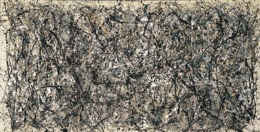
Jackson Pollock, One (Number 31, 1950), 1950, oil
and enamel on unprimed canvas,
8 feet 10 inches x 17 feet 5 5/8 inches (269.5 x 530.8 cm), Museum
of Modern Art, NY.

Jackson Pollock, The Deep, 1953, painting on canvas,
220.4 x 150.2 cm, Georges Pompidou Center, Paris.
Robert Motherwell (American, 1915-1991)
Philip Guston (American, 1913-1980), Barnett Newman (American, 1905-1970), c. 1960, ink on paper, Estate of Philip Guston, courtesy McKee Gallery, New York City.

Sam Francis (American, 1923-1994), In Lovely Blueness, 1955-1957, oil
on canvas, 300 x 700 cm,
Georges Pompidou Center, Paris.
Helen Frankenthaler (American, 1928-).
Photographs of the artists:

Nina Leen (American, 1909-1995), The Irascibles, 1950, Life magazine. Front row, left to right: Theodore Stamos, Jimmy Ernst (son of Max Ernst), Barnett Newman, James Brooks, Mark Rothko. Middle row: Richard Pousette-Dart, William Baziotes, Jackson Pollock, Clyfford Still, Robert Motherwell, Bradley Walker Tomlin. Back row: Willem De Kooning, Adolph Gottlieb, Ad Reinhardt, and Hedda Sterne.
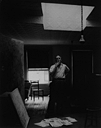
Arthur Swoger (American, 1912-), Philip Guston in his New York loft, 1957, gelatin silver print, Estate of Philip Guston, courtesy McKee Gallery, New York City.
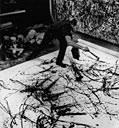
Hans Namuth (American, 1915-1990), Pollock painting, 1950, gelatin silver prints, National Portrait Gallery, Smithsonian Institution, Washington, D.C. This is one of at least five photographs Namuth made of Pollock painting. Their publication in Life magazine in 1951 caused a great sensation.
![]()
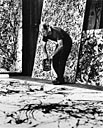
Here is a second one,
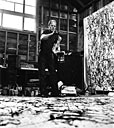
![]()
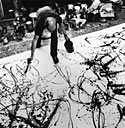
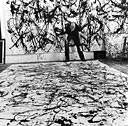
and a fifth.

Hans Namuth, Barnett Newman, Jackson Pollock, and Tony Smith at the Betty Parsons Gallery, gelatin silver print, April 1951, National Portrait Gallery, Washington, DC.
The nearest equivalent European movement is Tachisme.
https://inform.quest/_art
Copyright © 1996-![]()